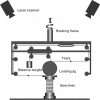Stepwise resection of the posterior ligamentous complex for stability of a thoracolumbar compression fracture: An in vitro biomechanical investigation
- PMID: 28858098
- PMCID: PMC5585492
- DOI: 10.1097/MD.0000000000007873
Stepwise resection of the posterior ligamentous complex for stability of a thoracolumbar compression fracture: An in vitro biomechanical investigation
Abstract
To quantify the mechanical contribution of posterior ligamentous structures to the stability of thoracolumbar compression fractures.Twelve fresh human T11-L3 spinal specimens were harvested in this study. The 1/3 L1 vertebral body was resected in a wedged shape. After the preinjury had been created, the specimens were subjected to flexion-compression to create a fracture model. Resection of the ligaments was performed in a sequential manner from the bilateral facet capsule ligament (FCL), interspinous ligament, and supraspinous ligament (SSL) to the ligamentum flavum at the T12-L1 level. Then, for the intact specimen, fracture model, and ligament disruption steps, the range of motion (ROM) and neutral zone (NZ) of T12-L1 and L1-L2 were collected for each simulated movement.Sequential transection of the posterior ligamentous complex (PLC), ROM, and NZ were increased in all movements at the T12-L1 segment. In the flexion-extension (FE), the ROM and NZ demonstrated significant increases after the fracture model and resection of SSL and LF. In lateral bending (LB), the ROM increased after the fracture and removal of the LF, while the NZ showed a slight increase. In axial rotation, the fracture model and removal of the LF resulted in a significant increase in the ROM, and the NZ showed a slight change after step reduction. For the L1-L2 segment, resection of the FCL led to an increased ROM in LB.With rupture of SSL or LF, the stability of the segment decreased significantly compared with the intact and fracture model, particularly in FE motion, the function of the PLC was considered to be incompetent.
Conflict of interest statement
The authors have no conflicts of interest to disclose.
Figures




Similar articles
-
Biomechanical Role of the Thoracolumbar Ligaments of the Posterior Ligamentous Complex: A Finite Element Study.World Neurosurg. 2018 Apr;112:e125-e133. doi: 10.1016/j.wneu.2017.12.171. Epub 2018 Jan 6. World Neurosurg. 2018. PMID: 29317367
-
Biomechanical evaluation of short-segment posterior instrumentation with and without crosslinks in a human cadaveric unstable thoracolumbar burst fracture model.Spine (Phila Pa 1976). 2010 Feb 1;35(3):278-85. doi: 10.1097/BRS.0b013e3181bda4e6. Spine (Phila Pa 1976). 2010. PMID: 20075769
-
Finite element analysis of wedge and biconcave deformity in four different height restoration after augmentation of osteoporotic vertebral compression fractures.J Orthop Surg Res. 2021 Feb 15;16(1):138. doi: 10.1186/s13018-021-02225-8. J Orthop Surg Res. 2021. PMID: 33588890 Free PMC article.
-
Three-column ligamentous extension injury of the thoracic spine: a case report and review of the literature.Spine (Phila Pa 1976). 2007 Dec 1;32(25):E785-8. doi: 10.1097/BRS.0b013e31815b60fd. Spine (Phila Pa 1976). 2007. PMID: 18245995 Review.
-
The Impact of Spine Pathology on Posterior Ligamentous Complex Structure and Function.Curr Rev Musculoskelet Med. 2023 Dec;16(12):616-626. doi: 10.1007/s12178-023-09873-9. Epub 2023 Oct 23. Curr Rev Musculoskelet Med. 2023. PMID: 37870725 Free PMC article. Review.
Cited by
-
Comparison of Short-Segment Pedicle Instrumentation with Supplemental Hook Fixation under Axial Compression in Relation to Graft Positioning and Posterior Ligamentous Integrity: A Biomechanical Study on the Calf Spine.Asian Spine J. 2021 Feb;15(1):64-71. doi: 10.31616/asj.2019.0222. Epub 2020 Jan 30. Asian Spine J. 2021. PMID: 31992025 Free PMC article.
-
Full-Endoscopic Approach Forchronic Low Back Pain from Baastrup's Disease: Interspinous Plasty.Orthop Surg. 2021 May;13(3):1102-1110. doi: 10.1111/os.12988. Epub 2021 Mar 29. Orthop Surg. 2021. PMID: 33783125 Free PMC article.
-
Role of Posterior Longitudinal Ligament Complex in Spinal Deformity Secondary to Surgical Resection of the Intradural Tumor.Orthop Surg. 2023 Mar;15(3):819-828. doi: 10.1111/os.13636. Epub 2023 Jan 31. Orthop Surg. 2023. PMID: 36720712 Free PMC article.
-
Biomechanical effects of sequential resection of the posterior ligamentous complex on intradiscal pressure and resistance to compression forces.Acta Orthop Traumatol Turc. 2019 Nov;53(6):502-506. doi: 10.1016/j.aott.2019.08.016. Epub 2019 Sep 16. Acta Orthop Traumatol Turc. 2019. PMID: 31537433 Free PMC article.
-
Lag-Screw Osteosynthesis in Thoracolumbar Pincer Fractures.Global Spine J. 2021 Sep;11(7):1089-1098. doi: 10.1177/2192568220941443. Epub 2020 Aug 3. Global Spine J. 2021. PMID: 32744071 Free PMC article.
References
-
- Behrsin JF, Briggs CA. Ligaments of the lumbar spine: a review. Surg Radiol Anat 1988;10:211–9. - PubMed
-
- McAfee PC, Yuan HA, Fredrickson BE, et al. The value of computed tomography in thoracolumbar fractures. An analysis of one hundred consecutive cases and a new classification. J Bone Joint Surg Am 1983;65:461–73. - PubMed
-
- Oner FC, van Gils AP, Faber JA, et al. Some complications of common treatment schemes of thoracolumbar spine fractures can be predicted with magnetic resonance imaging: prospective study of 53 patients with 71 fractures. Spine 2002;27:629–36. - PubMed
-
- Panjabi MM, Hoffman H, Kato Y, et al. Superiority of incremental trauma approach in experimental burst fracture studies. Clin Biomech 2000;15:73–8. - PubMed
Publication types
MeSH terms
LinkOut - more resources
Full Text Sources
Other Literature Sources
Medical

